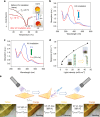Light-induced mechanical response in crosslinked liquid-crystalline polymers with photoswitchable glass transition temperatures
- PMID: 30104602
- PMCID: PMC6089925
- DOI: 10.1038/s41467-018-05744-x
Light-induced mechanical response in crosslinked liquid-crystalline polymers with photoswitchable glass transition temperatures
Abstract
Energy conversion of light into mechanical work is of fundamental interest in applications. In particular, diligent molecular design on nanoscale, in order to achieve efficient photomechanical effects on macroscopic scale, has become one of the most interesting study topics. Here, by incorporating a "photomelting" azobenzene monomer crosslinked into liquid crystalline (LC) networks, we generate photoresponsive polymer films that exhibit reversible photoswitchable glass transition temperatures (Tg) at room temperature (~20 °C) and photomechanical actuations under the stimulus of UV/visible light. The trans-to-cis isomerization of azo chromophores results in a change in Tg of the crosslinked LC polymers. The Tg of the polymer network is higher than room temperature in the trans-form and lower than room temperature in the cis-form. We demonstrate the photoswitchable Tg contribute to the photomechanical bending and a new mechanism for photomechanical bending that attributes the process to an inhomogeneous change in Tg of the film is proposed.
Conflict of interest statement
The authors declare no competing interests.
Figures




References
-
- Jiang BH, Kelch S, Lendlein A. Polymers move in response to light. Adv. Mater. 2006;18:1471–1475. doi: 10.1002/adma.200502266. - DOI
-
- Priimagi A, Barrett CJ, Shishido A. Recent twists in photoactuation and photoalignment control. J. Mater. Chem. C. 2014;2:7155–7162. doi: 10.1039/C4TC01236D. - DOI
-
- Manrique-juárez MD, et al. Switchable molecule-based materials for micro- and nanoscale actuating applications: achievements and prospects. Coord. Chem. Rev. 2016;308:395–408. doi: 10.1016/j.ccr.2015.04.005. - DOI
-
- Huck NPM, Jager WF, Lange BD, Feringa BL. Dynamic control and amplification of molecular chirality by circular polarized light. Science. 1996;273:1686–1688. doi: 10.1126/science.273.5282.1686. - DOI
-
- Hrozhyk UA, Serak SV, Tabiryan NV, Bunning TJ. Optical tuning of the reflection of cholesterics doped with azobenzene liquid crystals. Adv. Funct. Mater. 2007;17:1735–1742. doi: 10.1002/adfm.200600776. - DOI
Publication types
LinkOut - more resources
Full Text Sources
Other Literature Sources
Miscellaneous

